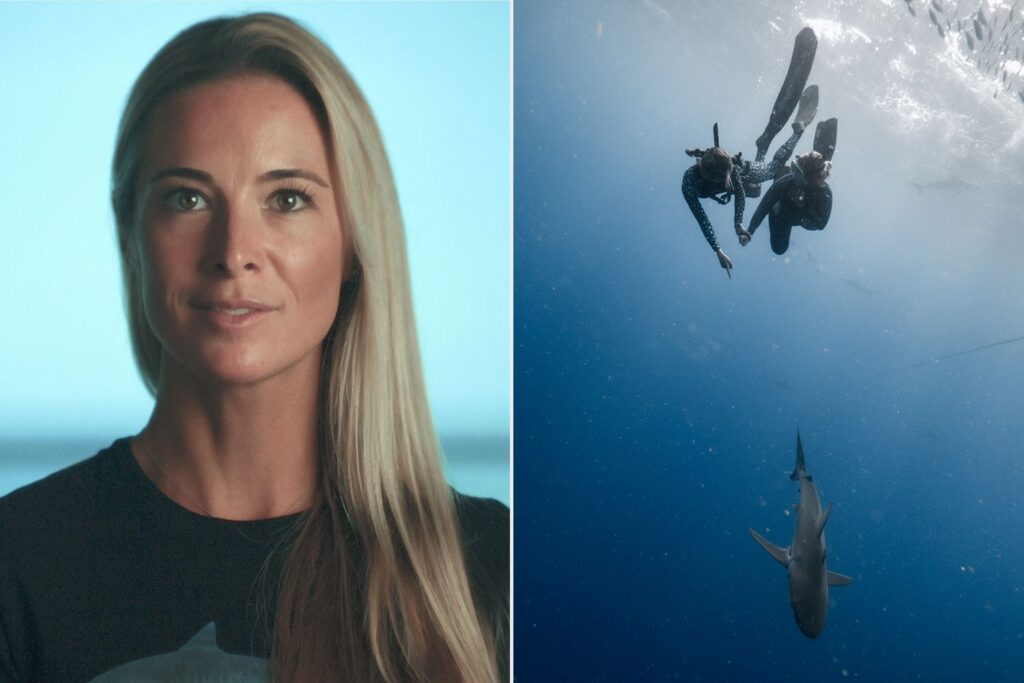NEED TO KNOW
Ocean Ramsey may not be afraid of sharks, but I am.
Blame Jaws, the opening scene of The Little Mermaid, or a lifetime of shark attack news coverage, but I’ve always had an irrational fear of the apex predators. As a Hawai’i resident, I’m familiar with “shark boats” in the area that charge tourists for supervised shark encounters, but I’ve never had the desire to go on one.
However, when I had the opportunity to face my fears head-on alongside Ramsey — the main subject of Netflix’s Shark Whisperer — and shark photographer and videographer Juan Oliphant with their company, One Ocean Diving, I accepted.
What I encountered 3 miles off the shore of Hale’iwa, Hawai’i, was nothing short of breathtaking. And I’m not just talking about the 27 Galapagos sharks that swarmed us.
Courtesy of Netflix
A professional diver and creator of her now-famous shark redirection technique, Ramsey has faced her share of criticism regarding her approach to shark conservation.
“Hand on top of the head, push down, lock out the elbows, stiff arm…to try and keep space. Then, follow through off the side. Second hand goes on or near behind the back of the jaw or by the gills,” Ramsey told PEOPLE of her technique in brief, reiterating that this is for emergencies only.
She has over 2.4 million followers on Instagram, and some say she’s pushing the boundaries with sharks “for the’ gram.”
After spending time in the water with Ramsey and Oliphant, I challenge that notion.
Fresh off a press tour and in the middle of a new research project, Ramsey did not appear exhausted on the day of our shark dive, as one might expect. She assured me that it was quite the opposite; according to her, this was “the invigorating part” — educating others about sharks.
Matthew Evans (Instagram:@mevans283)
After a small group of tourists and I boarded the boat, we listened to the captain’s safety briefing. Then Ramsey and shark safety diver Gina Glazer gave an overview of the types of sharks we might see, their social hierarchy and swimming patterns, and, perhaps most importantly, what to do if a shark approaches you: maintain eye contact, assume a vertical position, and tilt your fins forward to put an object between you and the shark.
They kept the tone fun and upbeat to ward off any last-minute jitters. Glazer wrapped up the briefing by emphasizing the number one rule, which was not “just have fun.” It was “respect the locals.” The locals, in this case, were the sharks, and this respect was a key part of our experience.
Matthew Evans (Instagram:@mevans283)
Even though the water was choppy that day, as we pulled up to the site, I could already see the sharks swimming underneath the water’s surface. Upon Ramsey’s instruction, I put on my mask and fins and slid into the ocean.
As I stuck my head underwater, all I could see was an infinity of deep, dark blue — and shark after shark swimming underneath me. Adrenaline soared through my body, but once I realized the sharks were content swimming down there, and none of them were coming to “get” me, as I’d been conditioned to believe, I felt surprisingly calm.
Matthew Evans (Instagram:@mevans283)
While in the water, we held onto a safety line attached to the boat, allowing us to observe the sharks in their natural habitat. Each person in our group also had the opportunity to go one by one with a trained professional to get closer to the sharks and even freedive above them.
Never miss a story — sign up for PEOPLE’s free daily newsletter to stay up-to-date on the best of what PEOPLE has to offer, from celebrity news to compelling human interest stories.
For me, the optional freediving was the most nerve-wracking part of the experience, because I can’t hold my breath for very long. Ramsey (who has a six-and-a-half-minute underwater breathhold) was incredibly patient. She held my hand through my first few dives and instructed me where it was safe to go, and I could feel her calmness flow through me.
Matthew Evans (Instagram:@mevans283)
On one of our freedives, she showed me a fishhook that was stuck in one of the shark’s eyes, a likely consequence of the now-illegal practice of shark fishing. Oliphant pointed out a few of the local sharks they “know,” thanks to tagging efforts and years of meticulous notes about the sharks’ markings and other unique features.
Matthew Evans (Instagram:@mevans283)
There were moments when I’d see a shark approaching, and a powerful alertness would run through my body. Then the shark would turn and swim in another direction, leaving me awestruck. I didn’t witness Ramsey or any of the safety divers use the shark redirection technique that day, which confirmed to me that it’s reserved for emergencies.
Matthew Evans (Instagram:@mevans283)
While it was fascinating to watch the sharks approach the group and then turn away, it was equally fascinating to watch Ramsey and Oliphant. Ramsey’s quiet confidence and Oliphant’s contagious enthusiasm (both in and out of the water) were tangible. Ramsey, in particular, truly looked at home while videoing and observing.
Matthew Evans (Instagram:@mevans283)
I was in awe of the entire operation; there we were, miles offshore, observing these sharks in their habitat while trying to control our breathing and slow our heart rates. Meanwhile, Ramsey, Oliphant, and the safety divers appeared cool as cucumbers while remaining hyper-alert.
For the most part, the entire experience felt incredibly peaceful. It was almost meditative to witness these apex predators swimming around in their natural habitat, utterly unconcerned with the wide-eyed humans staring down at them from above.
Matthew Evans (Instagram:@mevans283)
“How many sharks were there? Hundreds?” I asked excitedly as I boarded the boat and took off my gear. Oliphant laughed and let out an “I wish!” while Ramsey confidently noted, “27.”
Shortly after, she pulled up her database and typed out the details of the day, including the number of shark sightings, the species (Galapagos), and the sharks with signs of human impact (three, including the shark with the hook in its eye).
It was then that I learned that all that GoPro footage wasn’t just “for the ‘gram,” it also serves as a visual documentation for ongoing research. Ramsey assured me that every dive is an opportunity to learn, and no detail is too small. She even notes the outfits she wears while diving in case specific patterns of behavior arise in conjunction with different colors or designs.
On the way back to shore, Ramsey gave the group a debriefing on conservation efforts, the importance of sharks’ roles in our oceans, and things we can do to ensure that these incredible creatures don’t become extinct.
Matthew Evans (Instagram:@mevans283)
When I was back home reflecting on the experience, I began sobbing while explaining to a friend how extraordinary the entire morning had been. In the days of doom-scrolling, bed-rotting, and binge-watching, spending a morning in the water being fully present felt like a real gift. And let’s face it, you need to stay focused when 27 sharks are swimming below you.
Am I still afraid of sharks? Yes, but I’d like to think it’s a healthier, more respectful fear instead of an irrational, gory kind. I now have a much better understanding of shark behavior, their importance to the ecosystem, and how my own choices can affect their future.

